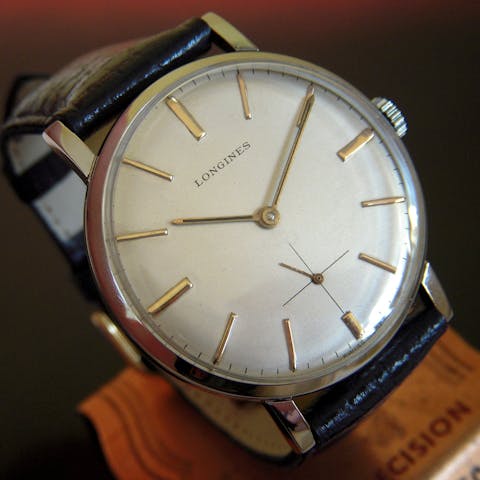Learn About Longines
In a world that values class and luxury, it is no doubt that Longines possesses one of the highest reputations of finery and high quality in watchmaking, suiting the needs of their customers and admirers since 1832.
Mechanical device of a Longines
With such a longstanding and highly regarded level of appreciation, it is no wonder that today their products enjoy the status of collectible items, and watch wearers and enthusiasts across the world look towards the brand and their products with captivation and admiration. From the rise of the Industrial Revolution in Europe to the modern sensibilities of the 21st century, Longines has evolved from a small local business to a worldwide enterprise that would establish Swiss watchmaking as the best in the world. With such a long and well established history, the story of the company is a fascinating one.
Company origins
In 1832, Auguste Agassiz, brother of world renowned biologist Louis Agassiz, founds the Raiguel Jeune & Cie watchmaking company in Saint-Imier, France, alongside his two partners, Henri Raiguel, and Florian Morel. In 1846, Agassiz would become the sole head of the company; by this time the company was already largely successful in the United States due to Agassiz’s family contacts abroad. Within the next decade, trained economist Ernest Francillon would join the company which he would later come to inherit and truly establish the company as a force to be reckoned with amongst a competitive market.
First success
In 1867, Agassiz passes control of the company over to Francillon. In this same year, the company produces its first movement, or the mechanical system that allows for a watch to operate, and it wins an award at the Universal Exhibition in Paris for its innovation. Francillon incorporated industrial elements to the company and established the company’s first factory in St. Imier, within an area locally known as ‘Les Longines’, or long meadows, thus earning the company its new brand name.

The next level
To maximize production and factory efficiency, Francillon hires engineer Jacques David as Technical Director and head of a new second factory. In 1876 David travels to Philadelphia for the Universal Exhibition on behalf of the Societé Intercantonale des Industries du Jura. Based on knowledge gained from his visit, he wrote a 108-page report detailing the methods techniques employed by American watchmakers, concluding that Swiss watchmakers would have to put in great efforts to keep up with American competitors. This report would become regarded as one of the most important documents in the history of watchmaking.
" By 1886, Longines watches were the timing device of choice for most professional New York sporting officials."
Two years later, taking this information into account, Longines produced the 20H caliber, which featured a simple chronograph movement. It was the first mechanism of the company that could be used for precise timing, a forefront of watchmaking technology in the 19th century. Since it could be used as a stopper for professional sporting events, the company quickly earned a fine reputation amongst equestrian sports. By 1886, Longines watches were the timing device of choice for most professional New York sporting officials.
By the 1880’s, Longines’ products were so highly esteemed for their accuracy, precision, and effectivity, that counterfeiters sought to replicate their watches using cheaper materials and production methods, and knock-offs were rampant. In order to combat this, Francillon trademarked the Longines name, and later the iconic winged hourglass logo, thus permanently sealing the brand’s reputation as a distinguished and professional-geared company.
New horizons
Throughout the following decades, Longines would be a pioneer of frontiers in exploration and technology; in 1899, Prince Luigi Amedeo of Savoie, Duke of the Abbruzi, embarks on an expedition of the Arctic wearing a Longines watch. In 1900 the brand wins more awards than any other at the Grand Prix Universal Expedition in Paris. In 1931, Charles Lindbergh works collaboratively with the company to create an aviation watch named Longines Weems, after naval officer, inventor, and author P.V.H Weems.
Across the board, Longines has consistently proven to be a forerunner of innovation and technology, achieving feat after feat from its very beginning up until now. It is no wonder that the company continues to maintain its standard of perfection, adapting to the modern world while still drawing from tradition in order to produce a truly elegant, stylish, and timeless product.

